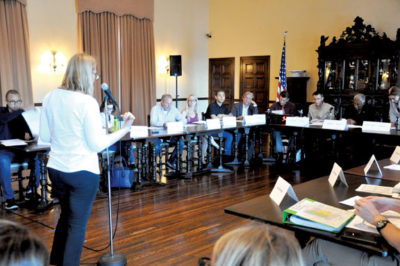SB 1818: How a state law is reshaping Larchmont

RESIDENT Tracey Clarke asks the GWNC to withdraw support from a proposed five-story building on Melrose Ave., bordering Larchmont Village.
A group of Larchmont Village residents continues to campaign against a new 52-unit mixed-use development planned for the corner of Beachwood Dr. and Melrose Ave. that is working its way through the planning process.
At the Greater Wilshire Neighborhood Council (GWNC) board meeting last month, Tracey Clarke, organizer of the opposition campaign, asked board members to reconsider its previous vote to support the project:
“I will be back next month to formally ask for the repeal of your support for this project until these issues are addressed,” said the Plymouth Blvd. resident.
According to Clarke, issues such as parking availability and noise from a pool and rooftop deck have not been adequately resolved, and the apartment building’s proposed height of 56 feet (five stories) is unacceptable to neighboring residents.
Alison Kelly, a Lucerne Blvd. resident, told board members that she understands “development is going to happen,” but that she doesn’t want the building to be five stories high: “Paramount is limited to 45 feet [generally three stories], so I don’t think it’s right for this development to go higher than that.”
With the proposed Beachwood/Melrose apartment building’s height at the crux of the controversy, it raises the question: why are developers allowed to build five story projects next to single-family neighborhoods?
The answer is a statewide density bonus law, Senate Bill 1818, that took power away from local planning authorities in an attempt to create more affordable housing.
SB 1818
Adopted in 2004, SB 1818 amended the state’s previous density bonus law to make the statute even more favorable to builders. Specifically, it significantly reduced the number of affordable units that a developer needs to provide to receive a density bonus.
The bill was authored and introduced by former ultra-conservative lawmaker, Dennis Hollingsworth, from the small city of Murrieta in western Riverside County. He represented California’s 36th state senate district from 2002 to 2010. (You might recognize the name: Hollingsworth was the proponent for the Prop. 8 ban on same-sex marriage.)
Critics of SB 1818 say that it’s an ill-conceived, one-size-fits-all approach that overlays density across entire cities without regard for the character of neighborhoods or the sufficiency of infrastructure.
Former Los Angeles County Supervisor Zev Yaroslavsky recognized these issues when he predicted in 2007 that the density bonus would “take a wrecking ball to some of the most beautiful, quaint neighborhoods in Los Angeles.”
All politics is local
In short, SB 1818 is the reason that a new mixed-use building adjoining Larchmont Village can be five stories high.
While residents like Clarke and Kelly are frustrated that the Planning Department would approve such height, the truth is, a blunt state law ties the city’s hands.
Within the City Planning Department’s recommendation report for the project, planners note that the property is permitted “by-right” to construct a maximum of 39 residential units. However, because the project’s developers restricted 11% (four units) of the permitted 39 units for very low-income households, “the project qualifies for a density bonus increase of 35%.”
Essentially, that means that by offering four units at a reduced price, the project can legally add 14 additional units while also increasing the building’s height without any consideration to Larchmont’s historic neighborhood. You can thank former Sen. Hollingsworth, the State Legislature and the Governor for that.
Category: News







